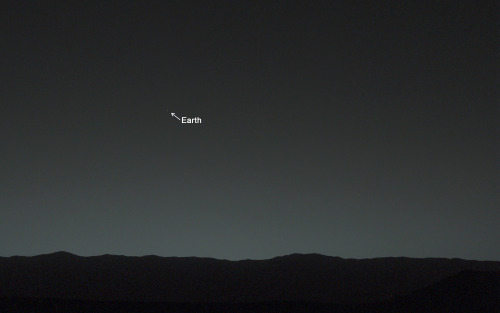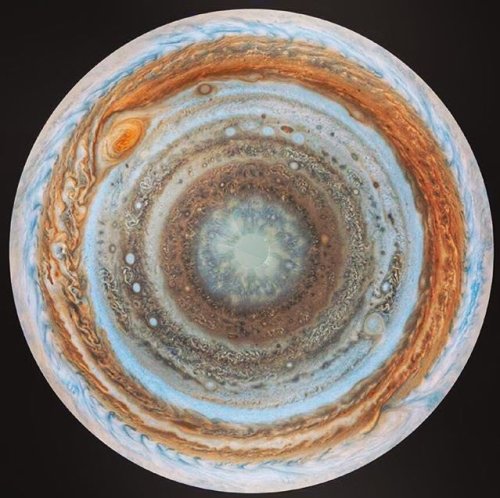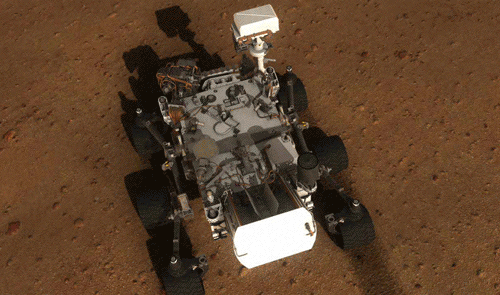Looking Forward, Looking Back. I’m Leaving Mars’ Naukluft Plateau, And Heading Higher On Mt. Sharp.

Looking forward, looking back. I’m leaving Mars’ Naukluft Plateau, and heading higher on Mt. Sharp.

I’ve analyzed my 12th drilled sample of Mars. Each drill hole is about 0.6 inch (1.6 centimeters)—slightly smaller than a U.S. dime. These images are raw color as taken by the camera at then end of my robotic arm.
The “Oudam” sample came from mudstone bedrock. Read more at http://go.nasa.gov/1UPba3F
More Posts from Jpl-official-blog and Others




A Martian Sunset
The 34mm eye of the Mastcam aboard Curiosity took this view of the sun setting over Gale Crater on sol 956 of the mission (April 15, 2015).
Credit: NASA / JPL-Caltech / MSSS / Damia Bouic


Happy “Back to the Future Day”!
Find out more about @nasa‘s real journey to Mars:
https://www.nasa.gov/journeytomars

Earth, you are my wishing star. Here’s how you look from my home on the surface of Mars.

Keyhole in the Carina Nebula


Jupiter’s south pole, taken by Cassini
NASA Climate Modeling Suggests Venus May Have Been Habitable
NASA logo. Aug. 11, 2016 Venus may have had a shallow liquid-water ocean and habitable surface temperatures for up to 2 billion years of its early history, according to computer modeling of the planet’s ancient climate by scientists at NASA’s Goddard Institute for Space Studies (GISS) in New York. The findings, published this week in the journal Geophysical Research Letters, were obtained with a model similar to the type used to predict future climate change on Earth. “Many of the same tools we use to model climate change on Earth can be adapted to study climates on other planets, both past and present,” said Michael Way, a researcher at GISS and the paper’s lead author. “These results show ancient Venus may have been a very different place than it is today.” Venus today is a hellish world. It has a crushing carbon dioxide atmosphere 90 times as thick as Earth’s. There is almost no water vapor. Temperatures reach 864 degrees Fahrenheit (462 degrees Celsius) at its surface.
Image above: Observations suggest Venus may have had water oceans in its distant past. A land-ocean pattern like that above was used in a climate model to show how storm clouds could have shielded ancient Venus from strong sunlight and made the planet habitable. Image Credit: NASA. Scientists long have theorized that Venus formed out of ingredients similar to Earth’s, but followed a different evolutionary path. Measurements by NASA’s Pioneer mission to Venus in the 1980s first suggested Venus originally may have had an ocean. However, Venus is closer to the sun than Earth and receives far more sunlight. As a result, the planet’s early ocean evaporated, water-vapor molecules were broken apart by ultraviolet radiation, and hydrogen escaped to space. With no water left on the surface, carbon dioxide built up in the atmosphere, leading to a so-called runaway greenhouse effect that created present conditions. Previous studies have shown that how fast a planet spins on its axis affects whether it has a habitable climate. A day on Venus is 117 Earth days. Until recently, it was assumed that a thick atmosphere like that of modern Venus was required for the planet to have today’s slow rotation rate. However, newer research has shown that a thin atmosphere like that of modern Earth could have produced the same result. That means an ancient Venus with an Earth-like atmosphere could have had the same rotation rate it has today. Another factor that impacts a planet’s climate is topography. The GISS team postulated ancient Venus had more dry land overall than Earth, especially in the tropics. That limits the amount of water evaporated from the oceans and, as a result, the greenhouse effect by water vapor. This type of surface appears ideal for making a planet habitable; there seems to have been enough water to support abundant life, with sufficient land to reduce the planet’s sensitivity to changes from incoming sunlight. Way and his GISS colleagues simulated conditions of a hypothetical early Venus with an atmosphere similar to Earth’s, a day as long as Venus’ current day, and a shallow ocean consistent with early data from the Pioneer spacecraft. The researchers added information about Venus’ topography from radar measurements taken by NASA’s Magellan mission in the 1990s, and filled the lowlands with water, leaving the highlands exposed as Venusian continents. The study also factored in an ancient sun that was up to 30 percent dimmer. Even so, ancient Venus still received about 40 percent more sunlight than Earth does today. “In the GISS model’s simulation, Venus’ slow spin exposes its dayside to the sun for almost two months at a time,” co-author and fellow GISS scientist Anthony Del Genio said. “This warms the surface and produces rain that creates a thick layer of clouds, which acts like an umbrella to shield the surface from much of the solar heating. The result is mean climate temperatures that are actually a few degrees cooler than Earth’s today.” The research was done as part of NASA’s Planetary Science Astrobiology program through the Nexus for Exoplanet System Science (NExSS) program, which seeks to accelerate the search for life on planets orbiting other stars, or exoplanets, by combining insights from the fields of astrophysics, planetary science, heliophysics, and Earth science. The findings have direct implications for future NASA missions, such as the Transiting Exoplanet Survey Satellite and James Webb Space Telescope, which will try to detect possible habitable planets and characterize their atmospheres. Related Links Read the paper in Geophysical Research Letters: http://www.onlinelibrary.wiley.com/doi/10.1002/2016GL069790/abstract NASA GISS’ NExSS activities: http://www.giss.nasa.gov/projects/astrobio/ NASA GISS website: http://www.giss.nasa.gov/ Image (mentioned), Text, Credits: NASA’s Goddard Institute for Space Studies, by Michael Cabbage and Leslie McCarthy/Rob Garner. Greetings, Orbiter.ch Full article




Curiosity Finds Active and Ancient Organic Chemistry on Mars
NASA’s Mars Curiosity rover has measured a tenfold spike in methane, an organic chemical, in the atmosphere around it and detected other organic molecules in a rock-powder sample collected by the robotic laboratory’s drill.
Researchers used Curiosity’s onboard Sample Analysis at Mars (SAM) laboratory a dozen times in a 20-month period to sniff methane in the atmosphere. During two of those months, in late 2013 and early 2014, four measurements averaged seven parts per billion. Before and after that, readings averaged only one-tenth that level.
Curiosity also detected different Martian organic chemicals in powder drilled from a rock dubbed Cumberland, the first definitive detection of organics in surface materials of Mars. These Martian organics could either have formed on Mars or been delivered to Mars by meteorites.
Organic molecules, which contain carbon and usually hydrogen, are chemical building blocks of life, although they can exist without the presence of life. Curiosity’s findings from analyzing samples of atmosphere and rock powder do not reveal whether Mars has ever harbored living microbes, but the findings do shed light on a chemically active modern Mars and on favorable conditions for life on ancient Mars.
For more information:
Mars methane detection and variability at Gale crater
Habitability, Taphonomy, and the Search for Organic Carbon on Mars
Recent Findings from NASA’s Curiosity Rover about Modern and Ancient Mars
Credit: NASA/JPL-Caltech/MSSS
Hues in a Crater Slope
NASA - Mars Reconnaissance Orbiter (MRO) logo. Jan. 4, 2017
Impact craters expose the subsurface materials on the steep slopes of Mars. However, these slopes often experience rockfalls and debris avalanches that keep the surface clean of dust, revealing a variety of hues, like in this enhanced-color image from NASA’s Mars Reconnaissance Orbiter, representing different rock types. The bright reddish material at the top of the crater rim is from a coating of the Martian dust. The long streamers of material are from downslope movements. Also revealed in this slope are a variety of bedrock textures, with a mix of layered and jumbled deposits. This sample is typical of the Martian highlands, with lava flows and water-lain materials depositing layers, then broken up and jumbled by many impact events. This image was acquired by the High Resolution Imaging Science Experiment (HiRISE) camera on Feb. 28, 2011 at 15:24 local Mars time. It is a stereo pair with image ESP_021454_1550. The University of Arizona, Tucson, operates HiRISE, which was built by Ball Aerospace & Technologies Corp., Boulder, Colo. NASA’s Jet Propulsion Laboratory, a division of Caltech in Pasadena, California, manages the Mars Reconnaissance Orbiter Project for NASA’s Science Mission Directorate, Washington. Additional image products: HiRISE, University of Arizona: http://www.uahirise.org/ESP_021520_1550 Mars Reconnaissance Orbiter (MRO): http://www.nasa.gov/mission_pages/MRO/main/index.html Image, Text, Credits: NASA/JPL/Sarah Loff/University of Arizona/Caption: Alfred McEwen. Greetings, Orbiter.ch Full article
-
 you-know-the-usual liked this · 3 years ago
you-know-the-usual liked this · 3 years ago -
 mi9dre5lec2ion liked this · 5 years ago
mi9dre5lec2ion liked this · 5 years ago -
 i-love-books-because-reasons liked this · 6 years ago
i-love-books-because-reasons liked this · 6 years ago -
 theseviolentdelights-insta liked this · 6 years ago
theseviolentdelights-insta liked this · 6 years ago -
 supacutiepie liked this · 6 years ago
supacutiepie liked this · 6 years ago -
 goldencipher1903 liked this · 6 years ago
goldencipher1903 liked this · 6 years ago -
 urlxfry-blog liked this · 6 years ago
urlxfry-blog liked this · 6 years ago -
 shambalasims liked this · 6 years ago
shambalasims liked this · 6 years ago -
 class42warship liked this · 6 years ago
class42warship liked this · 6 years ago -
 ball-lightning liked this · 6 years ago
ball-lightning liked this · 6 years ago -
 thelegsofsharks liked this · 6 years ago
thelegsofsharks liked this · 6 years ago -
 americannnot liked this · 7 years ago
americannnot liked this · 7 years ago -
 silverwolf02001 liked this · 7 years ago
silverwolf02001 liked this · 7 years ago -
 graverobbber liked this · 7 years ago
graverobbber liked this · 7 years ago -
 sweethoneybear liked this · 7 years ago
sweethoneybear liked this · 7 years ago -
 go-juan-stuff-blog liked this · 7 years ago
go-juan-stuff-blog liked this · 7 years ago -
 astrouniuni5000 reblogged this · 7 years ago
astrouniuni5000 reblogged this · 7 years ago -
 alien-angelworlds liked this · 7 years ago
alien-angelworlds liked this · 7 years ago -
 airdreams-blog1 liked this · 7 years ago
airdreams-blog1 liked this · 7 years ago -
 memories-were-not liked this · 7 years ago
memories-were-not liked this · 7 years ago -
 namelesswonder885 liked this · 7 years ago
namelesswonder885 liked this · 7 years ago -
 spiderbat-from-hell-blog reblogged this · 7 years ago
spiderbat-from-hell-blog reblogged this · 7 years ago -
 spellshite liked this · 7 years ago
spellshite liked this · 7 years ago -
 murderoftheuniverse liked this · 7 years ago
murderoftheuniverse liked this · 7 years ago -
 rabbithaver reblogged this · 7 years ago
rabbithaver reblogged this · 7 years ago -
 powerman1981 liked this · 7 years ago
powerman1981 liked this · 7 years ago -
 rwseif liked this · 7 years ago
rwseif liked this · 7 years ago -
 oiram53-blog liked this · 7 years ago
oiram53-blog liked this · 7 years ago -
 ominouswinchesters liked this · 7 years ago
ominouswinchesters liked this · 7 years ago -
 51m0n3s liked this · 7 years ago
51m0n3s liked this · 7 years ago -
 tosew-ez-blog liked this · 7 years ago
tosew-ez-blog liked this · 7 years ago -
 prebenbruno liked this · 7 years ago
prebenbruno liked this · 7 years ago -
 rory-pond1-blog liked this · 7 years ago
rory-pond1-blog liked this · 7 years ago -
 whoviankendokaqueenbeewithbooks liked this · 7 years ago
whoviankendokaqueenbeewithbooks liked this · 7 years ago -
 starry-eyed-butch liked this · 7 years ago
starry-eyed-butch liked this · 7 years ago -
 dwebble-downer liked this · 7 years ago
dwebble-downer liked this · 7 years ago -
 dancing-coyote liked this · 7 years ago
dancing-coyote liked this · 7 years ago -
 gremlinmidi liked this · 7 years ago
gremlinmidi liked this · 7 years ago -
 luckycheifd reblogged this · 7 years ago
luckycheifd reblogged this · 7 years ago
37 posts